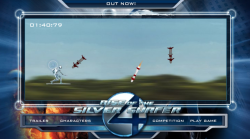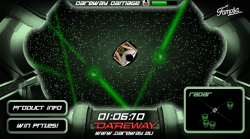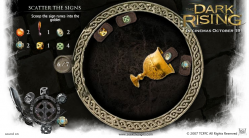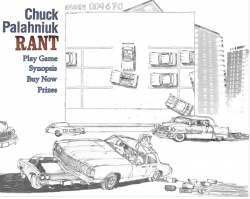Posts Tagged ‘microsite’
Rise of the Silver Surfer
Tuesday, July 8th, 2008 Use the mouse to dodge incoming missiles in this fast paced side scrolling action game. How long can you last?
Use the mouse to dodge incoming missiles in this fast paced side scrolling action game. How long can you last?
Postmortem:
Behind this basic looking game lies a well tuned piece of gameplay. Anyone can pick this game up in seconds and it feels good to float about on a flying surfboard, but mastery is a tricky task. At it’s heart, there’s just one task – dodge missiles. And only two types of missile too – straight ones and seeking ones. Behind the scenes though there’s a subtle level progression that takes you through some 15 or so different stages of types of attacks. From one at a time, through waves of attacks, to an endless onslaught. You can really get into a rythem of dodging and it feels great when you get into that flow state, diving one way or another almost omnisciently.
The game played awful for a while due to not being able to see/anticipate where the next missile was coming from before it was on top of you. The addition of arrows at the edges that grew as the missiles got closer helped a lot, then the final touch of a launch sound that subtly prompts the player to look out for a new arrow finalised the gameplay feel.
The motion of the Surfer himself mattered a lot too. He needs to be flingable, but also controllable. To move fast when needed, but also to have precise control when required. This is achieved with a fairly complex system of accelerating towards the mouse faster the further away he is, and progressively more damping the closer to the mouse he gets so he doesn’t overshoot and oscillate wildly.
The game looks like a sideways scroller, whizzing over trees at a tremendous rate. The background scroll is a simple looping tween however, and all the gameplay is static on top. Even when I tell myself this whilst playing, it’s a powerful enough illusion to give me a real sense of speed.
One of the few issues I have with the game is that it only becomes really fun for the player when they are challenged to their skill level. When you’re learning to play, the game ramps up appropriately, but when you’ve played a few times already, you have to wade through the early easy levels to get to the fun bits. There wasn’t much scope for changing this in the project, but if I were to revisit this game I’d think up something to let you play on from where you were before.
Lessons:
- Simple games can be great fun if they feel just right
- Shortcuts can often work where a ‘proper’ solution would take longer and give very little tangible benifit
Tate to Tate
Friday, April 18th, 2008 Create a London scene and enter the competition with this little webtoy.
Create a London scene and enter the competition with this little webtoy.
Isabel Bookbinder Outfit Designer
Monday, April 14th, 2008 Use your mouse to design Isabel Bookbinder a fashionable outfit. You can save it into a gallery for all to see too. Click “outfit designer” to get started.
Use your mouse to design Isabel Bookbinder a fashionable outfit. You can save it into a gallery for all to see too. Click “outfit designer” to get started.
Dressup toys aren’t the most exciting of things for developers to build. It’s basically a drag+drop mechanism, and a bunch of graphics. That’s normally it. In this case however, I decided to add a little sparkle to the way things moved on screen by integrating my AS2 physics engine into the clothing. When you scroll the wardrobe, the items all dangle and sway in a satisfying manner. Hangers without clothing will rock about considerably more, and items will dangle from the mouse rather than just sticking firmly. It all adds a level of tactility that isn’t present in most dressup games.
Griffith Park Animation
Wednesday, March 5th, 2008 I created a couple of programmatic animations for the Griffith Park sparkling rose wine website. Most notably, the organic looking growing vines on the left and right of the screen. These are animated via the drawing API rather than on a timeline, and the motion appears more organic because of this.
I created a couple of programmatic animations for the Griffith Park sparkling rose wine website. Most notably, the organic looking growing vines on the left and right of the screen. These are animated via the drawing API rather than on a timeline, and the motion appears more organic because of this.
Scissor Sisters: Whack-a-Sister
Monday, December 17th, 2007 Use your mouse to wind back the mallet, then unleash it on a Scissor Sister when they light up and make a sound. The harder you can hit, the more you’ll score in this whack-a-mole style game.
Use your mouse to wind back the mallet, then unleash it on a Scissor Sister when they light up and make a sound. The harder you can hit, the more you’ll score in this whack-a-mole style game.
Watch for the real-time ripple effect wherever you hit. It’s a bigger effect if you wind the mallet back further, and I haven’t seen this effect done elsewhere on the web yet. It’s produced by animating a displacement colour map filter over the clip that holds the Sisters.
Dareway Invasion
Thursday, October 11th, 2007 Use the cursor keys to dodge the incoming laser blasts from the aliens on your Dareway scooter.
Use the cursor keys to dodge the incoming laser blasts from the aliens on your Dareway scooter.
The Dareway itself is a cheap copy of the Segway scooter for children, only with none of the cleverness of the original. This microsite was to promote the toy, and the game was rushed together from the Silver Surfer games. It plays OK for a few minutes, but is never going to set the world alight with new concepts! Watch for the tell tale green glow of the laser lines approaching to anticipate where you’re being fired at from, and reposition yourself to avoid getting hit. Take too much damage and you’re out.
Dark is Rising
Friday, September 28th, 2007 A simple physics game as part of a microsite. Collect up the tiles and scatter them into the ring. There’s not a lot of game here, but the physics engine from Rant enhances the tactile feel of collecting and releasing the tiles.
A simple physics game as part of a microsite. Collect up the tiles and scatter them into the ring. There’s not a lot of game here, but the physics engine from Rant enhances the tactile feel of collecting and releasing the tiles.
Sonic Rush Adventure
Thursday, September 27th, 2007 Use the mouse in this simple matching game to find the hidden pairs. You’re against the clock, so work fast!
Use the mouse in this simple matching game to find the hidden pairs. You’re against the clock, so work fast!
Unusually for a pairs game, you can click as rapidly as you like. You don’t need to wait for the last two pairs to turn over before starting the next couple! Get to it and make it snappy.
Rant
Monday, May 14th, 2007 Cause the biggest pile-up you can in this quick-hit driving game. Use the cursor keys to race up the road and smash into the junction at the end. The more you hit, the better your score!
Cause the biggest pile-up you can in this quick-hit driving game. Use the cursor keys to race up the road and smash into the junction at the end. The more you hit, the better your score!
Postmortem:
Whilst messing about with an idea I had in my spare time, I ended up creating a basic AS2 physics engine for simulating masses and springs. It turned out to be just what was needed for the Rant game. Each car is two round masses joined together by a spring, with a car graphic pasted over the top. The resulting losenge shape isn’t really much like a car I know, but it is perfectly sufficient for the game as it stands.
Initially, I tried making the cars out of a box made from four masses and six springs holding them in position. This ran considerably slower as the collision detection had that much more work to do, and there were that many more springs to simulate. The results weren’t as good either, with boxes occasionally turning inside out and often wobbling like jelly. The two-mass system worked considerably better and was considerably cheaper on the CPU. All round win!
A typical game of Rant only lasts a few seconds. You race up the road, tap a few cars, get a score then it’s all over. It turned out in playtesting that the trick to making this addictive was to make it really easy to play again. So, spacebar to reset at any point (even before the game is over) was critical. Likewise, there’s no lengthy transition effect before you’re back in control. In fact, there’s not even a brief half-second transition – I found that it annoyed people to wait even for that when you can replay so rapidly.
Another way to reduce user friction was to store their high-score in their Flash Shared Object. I found that people got into a routine of restarting rapidly, and sometimes did so when they had a highscore by accident. Rather than lose the chance to submit it, I allow them to submit it at any point in the future after a game too. The highscore table automatically allows just one entry per person, so there’s no chance of one person filling the table when they’ve achieved a top score.
Ultimately, Rant is a game of luck. If you’re lucky, you can hit all three of the randomly placed speed boosts, catch a few cars just right on the junction itself and hit lots of parked cars for that magical score. The game keys into that ‘one more go’ trap that we’re all succeptible to, and a little bit into the semi-gambling gene that makes us play dice games like Yahtzee, even when there’s nothing other than a highscore at stake.
Lessons
- Very short games can increase replayability and addiction, since people don’t have to invest much time in each go
- … as long as there’s very little friction before playing again
- When simulating physical objects, go for the simplest underlying representation that will suffice
- You don’t always need a lot of gameplay to generate addiction

 RSS 2.0 full site
RSS 2.0 full site